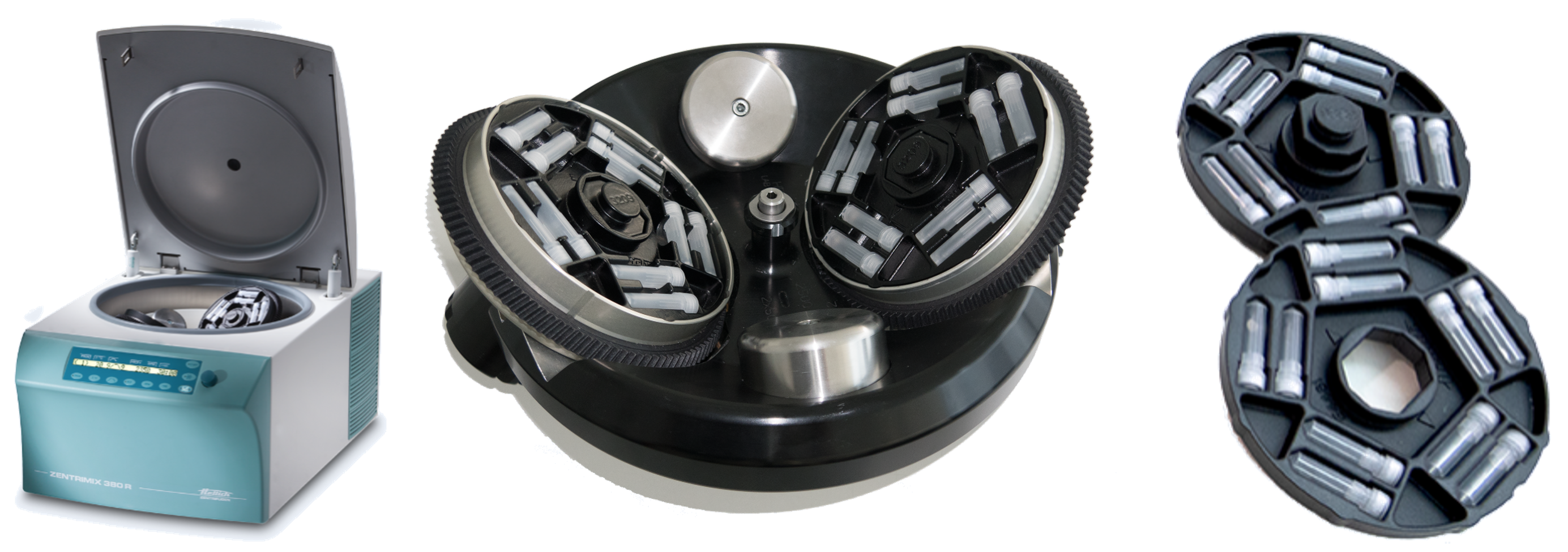Hettich – Efficient preparation of lipid nanoparticles by in-vial homogenization (ZentriMix 380 R)
Dr. Ulrich Massing, Andreas Hettich GmbH & Co KG, Föhrenstraße 12, 78532 Tuttlingen, Germany
The preparation of liposomes and several other lipid nanoparticles by homogenization is well proven and impresses with its simplicity and broad applicability. Disadvantages are the batch sizes, which are often far too large for research, and the high shear stress on the sample, which can lead to lipid hydrolysis and/or degradation of the active ingredient. The preparation of sterile samples is laborious and time-consuming.
A new homogenization-technique is the so called “in-vial homogenization”. This new method is based on a very special centrifugal technique, dual centrifugation, and is more suitable than any other methods for the rapid preparation of rather small batches of liposomes and other nanoparticles in a sterile, save and simple way.1) Consequently, in-vial homogenization is ideal for the development – including formulation screening – and preparation of liposomes for biomedical and pharmaceutical research. In addition, the new technique allows rapid “on-site production” of liposomes which have only a limited storage stability, e.g., in a clinical pharmacy. Andreas Hettich GmbH & Co KG, an experienced manufacturer of innovative and robust laboratory centrifuges, has developed the ZentriMix 380 R, a coolable dual centrifuge which is especially suitable for in-vial homogenization.2)

Fig. 1: ZentriMix 380 R, dual rotor and adapter for 2 ml twist-top vials.2)
In-vial homogenization
During dual centrifugation, tightly closed sample vials rotate around a central axis (normal centrifugal axis, primary rotation), but also around their own axis (secondary rotation). Thus, the high centrifugal acceleration rapidly changes its direction in relation to the rotating sample, causing high frequent (1.660 direction changes/min) and very strong movements of the sample inside the vial, a process which can be used for homogenization. To support the homogenization process, heavy zircon oxide (ZrO) beads are added to the samples.
Optimized dual rotor
Most optimal for introducing the maximal energy into the sample is the use of lengthy vials which are placed into the dual rotor at a 90° angle to the axis of the second rotation (Fig. 2A). This very special vial-orientation gives the sample the maximal way to accelerate, resulting in the strongest impact when the sample, containing heavy ZrO-beads, reaches the end of the vial.
Furthermore, also important for the impressive homogenization power is that the sample including the ZrO-beads glides along the inner vial wall which results in an additional “high-performance friction” of the samples (Fig. 2B). To make optimum use of this effect, Hettich had developed a dual rotor in which the axis of the secondary rotation has an 40° angle related to the primary rotational axis, allowing optimal sample gliding on a defined path inside the vials. The numerous homogenization events (sample turns every 36 milliseconds) in combination with the two powerful homogenization processes results in a very efficient but, at the same time, very gentle homogenization process.
Fig. 2: Basic principles of dual centrifugation. (A) Dual rotor with primary and secondary rotation. (B) Centrifugal acceleration is split into a vector of longitudinal acceleration that moves the sample along the sample vial and into a vector of sideward acceleration, that pushes the sample to one side of the sample vial. Longitudinal acceleration causes strong impact when the sample and beads reach the end of the vial (impact zone). Longitudinal and sideward acceleration together force the sample and beads to a defined glide path while moving along the vial which causes high-performance friction. (adapted from 1))
Wide range of nanoparticle preparations
Dual centrifugation (DC) is in use for the preparation of liposomes, which is the most frequent use, but also of other (lipid) nanoparticles such as emulsions, solid lipid nanoparticles (SLNs), polymersomes and nanocrystals (in-vial nanomilling), and is on its way to become the quasi-standard for simple, fast, and aseptic production of lipid nanoparticles in small and medium batch sizes (recently reviewed in 1)).
Unusual high entrapping efficiencies
Since in-vial homogenization works optimal with highly concentrated and thus viscous blends of lipids and buffer, the primary homogenization product is a vesicular phospholipid gel (VPG). VPGs are highly concentrated liposomal dispersions in which each liposome is in close contact with its neighbor vesicles, and simple dilution of a VPG results in a normal liposomal dispersion. Since the lipid concentration during homogenization is very high – and thus the ratio of entrapped water is high as well – entrapping efficiencies of water-soluble drug compounds are usually very high (> 50%).
Fig. 3: Basic procedure of manufacturing liposomes by dual centrifugation. (adapted from 1))
Small multilamellar vesicles (SMV)
A very special feature of in-vial homogenization is that it can be performed also with extremely high lipid concentrations of up to 60-70%. Using such high lipid concentrations, there is not enough water available to get water filled unilamellar liposomes. Instead, the excess of lipids goes into the liposomes, resulting in small multilamellar vesicles (SMV, typically < 200 nm), which can’t be prepared by high pressure homogenization or other means.3)
Summary
The new dual centrifuge “ZentriMix 380 R”, designed by Hettich, is a powerful tool to prepare various lipid nanoparticles in closed vials, especially liposomes. Because of the tightly closed vials, the process is intrinsically safe (no contact to the product) and can easily be performed in an aseptic way. The batches are rather small (a few milligrams up to a few grams), which allows the economic preparation of nanoparticles for biological studies, including animal studies, even if the active ingredient is rare and/or expensive.
Furthermore, a completely new type of liposomes can be prepared, SMVs, which are promising for entrapping not only water soluble, but also lipophilic or poorly dissolvable drug compounds. The dual centrifuge “ZentriMix 380 R” has rather huge rotating units to accommodate the sample vials, which allows preparation of up to 40 samples within one run, which safes lab time and easily allows formulation screening.
Preparation of Nanosized Pharmaceutical Formulations by Dual Centrifugation
Pharmaceuticals 16, 1519
| PubMed |


